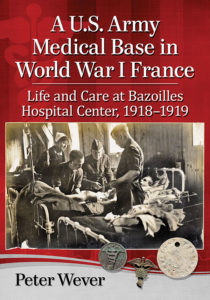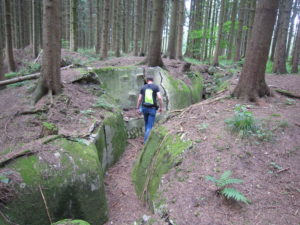Even today French locals, other Europeans and Americans find themselves drawn to the Meuse-Argonne region of France. Once drawn there, many return time and again; often working on a multi-year research or preservation project. In this irregular interview series, the webmaster hopes to introduce readers to some of these individuals and their labors of love.
1) What are your name, nationality and occupation?
Peter Wever, from the Netherlands, medical doctor in a general hospital. Hence the nickname “Doc.”
2) Which languages do you speak, and how fluently do you speak them?
Dutch and English fluently, Deutsch ein bisschen, French un petit peu.
3) When was your first visit to the Meuse-Argonne?
In 1999, when my parents-in-law moved from the Netherlands to a small village near Bar-le-Duc, in the Meuse Department, south of Verdun. In the barn of their farm they found a WW1-era French canteen which they gave to me.
4) When did you really find yourself drawn to the Meuse-Argonne?
In 2010, I made a battlefield trip with friends under the guidance of Jean-Paul de Vries. That same afternoon we headed out into the forest ourselves.
5) What is your primary interest in the region?
I have an interest in medical history and, therefore, in the operations of the U.S. Army Medical Department during the Meuse-Argonne Offensive.
6) Approximately how many times and/or how often do you visit the Meuse-Argonne?
After my mother-in-law passed away in 2014, my father-in-law sold the house and returned to the Netherlands. Therefore, the number of times has unfortunately greatly diminished to about four or five times a year.
7) What do you do when you visit?
I visit the Meuse-Argonne American Cemetery during each visit to pay my respects in general and I visit the two graves adopted by my son and me. I also walk through the woods trying to locate former German Lagers (camps); search for former hospital sites; and take then and now pictures.
8) What research or preservation projects are you working on currently?
I bought a clinical notebook kept by an American soldier working at a hospital just south of the Argonne Forest. It lists personal details of 73 wounded soldiers, their injuries and their treatment. These cases will be the thread of a book I am currently working on. I am running a Facebook page “Bazoilles Hospital Center, 1918-1919” for reasons explained in the next answer. I am also chairman of the Living History group, “Tommy’s Sisters,” which reenacts a British Casualty Clearing Station in which I portray a bacteriologist and my daughter a VAD. Recently, Sjoerd van der Ven started the living history group “355th AEF” in which I portray a medical corpsman and my son a private.
9) What research or preservation projects have you completed in the past?
I found friends in Maarten and Didi Otte who run a B&B in Nantillois with the Meuse-Argonne 1918 Museum attached to it. I self-published the first two books written by Maarten, who is now an author with Pen & Sword. I curated the exhibition “Wounds, Disease and Medical Care in the 1918 Meuse-Argonne Offensive” in the Nantillois Museum, while currently my exhibition “American Forces of the Meuse-Argonne Offensive” is on display. From 2015 onwards, I worked on a book about Bazoilles Hospital Center, the first of its kind, where over 63,000 American soldiers were treated in ten months’ time. This resulted in the book, “A U.S. Army Medical Base in World War I France: Life and Care at Bazoilles Hospital Center, 1918 – 1919,” published by McFarland and available through Amazon. I have written articles about medical aspects of WW1 for medical journals, including a contribution in the somewhat prestigious Christmas issue of the British Medical Journal about an air raid on British No. 10 Stationary Hospital in St. Omer.
10) What is your favorite part of the Meuse-Argonne and why?
If you walk westwards from the Abri du Kronprinz towards the former German Witte Lager, you walk through majestic conifers which grow from the soil that is still heavily scarred from the war. Beautiful and sad at the same time.
11) History aside, what is your favorite thing to do in the Meuse-Argonne?
An important reason for me to head out to the Meuse-Argonne is to find distraction and relaxation from sometimes stressful work in the hospital. So I guess it would simply be “being over there.”
12) Schedule permitting, would you consider being a tour guide for individuals or groups traveling to the sector?
I have guided Dutchmen from the village where my parents-in-law lived through the Argonne Forest. But there are other people with much more knowledge of that region. I tend to think that I know quite a lot about hospitals once located there, but there is really not that much to see any more at those locations.
13) How can readers contact you for assistance or for more details?
Through Facebook or Messenger
14) Any other comments?
I think I have already been too elaborate…




